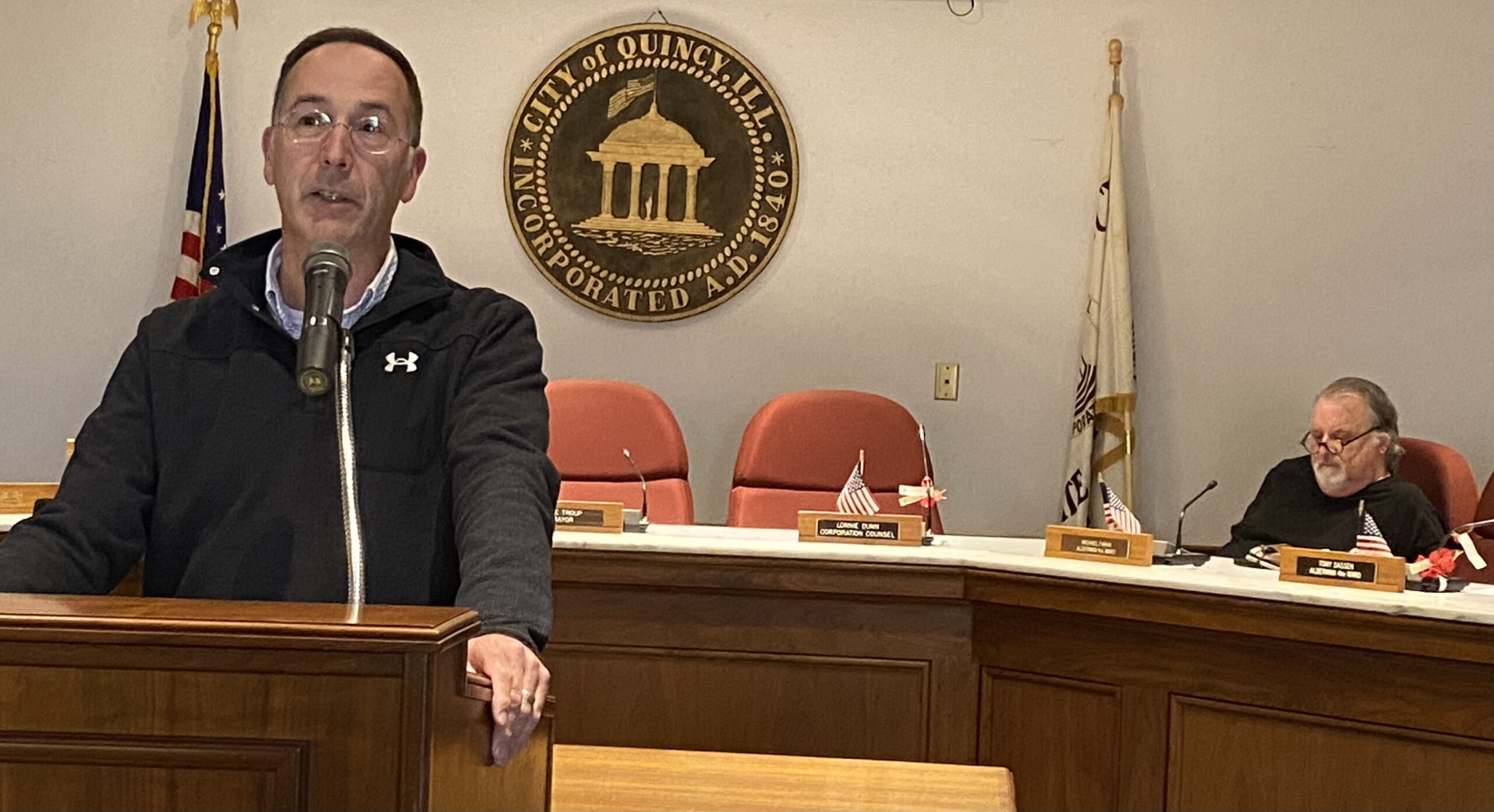Conte makes case for utility rate surcharge at public meeting; homeowners ask why industrial customers aren’t paying more

QUINCY — A public hearing to discuss a proposed monthly $9 surcharge on utility rates for Quincy homeowners provided a review of the finances and circumstances leading the creation of the ordinance.
While Jeffrey Conte, director of public works, presented other options to offset a projected $3 million increase in operating expenses to a small crowd that met Thursday night in City Council chambers, most were discussed briefly or not at all.
Instead, most of those in attendance wanted an explanation why the city’s 16,000 homeowners would see a 56 percent increase in their water and sewer rates. The average family with a five-eighths inch meter would see their bill increase from $40.49 to $49.49.
A commercial customer with a one-inch meter would see an 11.7 percent increase from $171 to $191. An industrial customer with a six-inch meter would see a 2 percent increase from $31,889 to $32,533. The rate hikes would offset the rising costs associated with making water from the Mississippi River consumable.
Conte provided figures showing 92.2 percent of the water and sewer customers are residential. However, they only consume 41.7 percent of the water and provide 53.2 percent of the revenue. Less than 8 percent of Quincy water customers — commercial and industrial — consume more than 58 percent of the water.
“Part of what makes Quincy attractive is our low water and sewer rates for industries that are heavily dependent on it,” Conte said. “We have customers that use a lot of water but can get water from other sources. You raise the rates too much, and they will use other sources because those other sources become less expensive. When that happens, the money that (industrial customers) were previously paying into the enterprise fund then gets shifted on the backs of residential customers.”
If aldermen approve a rate increase, Conte says Quincy’s utility rates still will be low compared to other medium-sized cities in central Illinois. Alderman John Mast, R-5, said other cities are paying higher utility rates because they don’t have Quincy’s industrial base.
“Industrial users in the Quincy area are already picking up a lion’s share, helping keep our rates low,” Mast said. “If we lose (industrial customers) to another water source or they move, we’re looking at rates similar to other locations. We’d probably be around $80 or $90 a month (for a residential user) if we lose our industrial base.”
Mike Farha, R-4, said Quincy has lost two of its largest industrial users of water — Prairie Farms and Celotex — in the past 15 years.
However, he also shared the concern of local taxpayers.
“We’re not growing. Our population base is falling,” he said. “(The proposed surcharge) does fall inordinately on those who use less, and I share their concern deeply. We forget about the poor. We forget about those people west of 12th Street. The burden is going to fall inordinately on them, and this problem isn’t going to go away.
“If (aldermen) pass this increase now, trust me, in 2023 and 2024, you’re going to be right back here. … When industry faces this, they cut expenses. They start by cutting things. They don’t start by raising rates. … I don’t understand why we have never figured out that in the last 10 years, our solution to everything is to spend more money.”
Conte said the enterprise fund for water and sewer was at $9,222,016 entering fiscal year 2013. If aldermen vote down the proposed ordinance and nothing further is done, he projected the fund would be nearly $10 million in the hole by the end of fiscal year 2017.
He said the city ended fiscal year 2022 with a $3.37 million net revenue to invest in capital projects. He said operating expenses are expected to cost $3.05 million more in fiscal year 2023. The city is projecting to finish with a net income of minus $40,000.
Conte noted the city’s water treatment plant is more than 100 years old.
“We have water mains that date back to the 1870s … lots of them,” he said. “Hundreds of miles of water mains that are leaking need to be repaired. It’s not going away.”
Conte said the expenses for energy (used to pump water), operating supplies and sludge disposal all have soared. Costs for phosphate, carbon dioxate and chlorine all have risen more than 200 percent. The cost of electricity per kilowatt hour has risen 115 percent. The cost of disposing sludge (46 percent) and biosolids (224 percent) are higher as well.
Other options to address the financial problems with the water treatment fans were part of Conte’s presentation. They were:
- Reducing the labor force
- Eliminating capital spending
- Finding alternatives for sludge disposal
- Converting biogas into electric
- Solar farms to create energy to pump water
Conte said he has heard suggestions to borrow money from ARPA (American Rescue Plan Act) funds or the city’s general fund. However, he called that a “band-aid solution.”
Eleven of the 14 aldermen were in attendance. Farha expressed his displeasure at the beginning of the meeting, saying he believed the city should compensate aldermen for attending the meeting that was called 48 hours earlier.
“It’s disrespectful to the public and it’s disrespectful to the aldermen who represent the public to have a last-minute meeting called,” he said. “That’s not the way to handle things. It’s insulting.”
Aldermen tabled a vote on the ordinance at Monday’s City Council meeting.
Miss Clipping Out Stories to Save for Later?
Click the Purchase Story button below to order a print of this story. We will print it for you on matte photo paper to keep forever.

